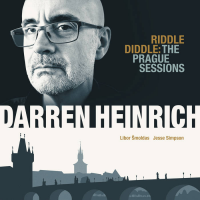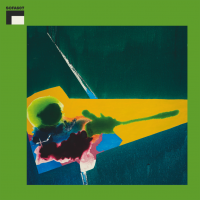Home » Jazz Articles » Extended Analysis » Mehmet Ali Sanlikol: Mehmet Sanlikol: What's Next?
Mehmet Ali Sanlikol: Mehmet Sanlikol: What's Next?
What's Next?, Sanlikol writes, was "more than a decade in the making," and indeed eight of its nine pieces were written during the years 1996-2000 (the exception is "Palindrome," commissioned by the American Islamic Congress in 2011). Even though Sanlikol draws on his Turkish heritage to underscore his essentially pleasing themes, the over-all complexion is one of American big-band jazz, well-written and expertly performed by Sanlikol and his colleagues. Certainly that is the case with the dynamic title track, which sounds much like the sort of unbridled flag-waver that would have been quite at home in the libraries of Herman, Basie, Rich or other big-band pacesetters. Even so, the Turkish influence is perceptible, as on "On the Edge of the Impossible," which combines American blues with "the Saba makam shared by Turkish and Arabic music"—not to mention the impact of one of Sanlikol's mentors, the late Bob Brookmeyer.
Another blues, suitably titled "The Blue Soul of Turkoromero," is leavened by Turkish folk music and the ney, which Sanlikol says is "an end-blown flute," and on which he solos. A wordless vocal and expansive piano solo (by Sanlikol) are prominent on the placid "Violet Longing," a warm bow to Esen's tutelage. While the plain-spoken "Kozan March" is derived from Turkish folk music, its rhythmic and harmonic framework is clearly based on the standard jazz idiom. Sanlikol uses a Moog synthesizer to deepen the shadowy spirit on the ballad "N.O.H.A," which precedes the pulsating finale, "Gone Crazy: A Noir Fantasy," dedicated to Hollywood films of that singular genre. Soloists on every number are unlisted, which is fine, as none rises above the ordinary. On the other hand, everyone is steadfastly bound to Sanlikol's perspective, and the ensemble bends to it task without respite. This is classic American-bred jazz with a slight Turkish accent, bold and refreshing in its own way and well worth hearing.
Track Listing
What’s Next?; Better Stay Home; A Violet Longing; Palindrome; On the Edge of the Extreme Possible; The Blue Soul of Turkoromero; Kozan March; N.O.H.A.; Gone Crazy: A Noir Fantasy.
Personnel
Mehmet Ali Sanlikol
multi-instrumentalistMehmet Ali Sanlikol: composer, arranger, conductor, piano, keyboards, voice. Track 1 — Mike Peipman: trumpet; Sam Dechenne: trumpet; Jeff Claassen: trumpet; Jerry Sabatini: trumpet; Mark Zaleski: alto sax; Sam Mehr: alto sax; Aaron Henry: tenor sax; Tucker Antell: tenor sax; Jared Sims: baritone sax; Clayton Dewalt: trombone; Randy Pingrey: trombone; Tim Lienhard: trombone; Ido Meshulam: bass trombone; Utar Artun: piano; Phil Sargent: electric guitar; Fernando Huergo: electric bass; Bertram Lehmann: drums. Track 2 — Sam Dechenne: trumpet; Mark Zaleski: alto sax; Aaron Henry: tenor sax; Kathy Olson: baritone sax; Chris Gagne: trombone; Mehmet Sanlikol: piano, keyboards, voice; Phil Sargent: electric guitar; Fernando Huergo: electric bass; Engin Gunaydin: drums. Track 3 — Jerry Sabatini: trumpet, flugelhorn; Sam Dechenne: trumpet, flugelhorn; Mark Zaleski: alto sax; Aaron Henry: tenor sax; Kathy Olson: baritone sax; Chris Gagne: trombone; Mehmet Sanlikol: piano, keyboards, voice; Phil Sargent: electric guitar; Fernando Huergo: electric bass; Cem Mutlu: drums; Engin Gunaydin: percussion. Track 4 — Mehmet Sanlikol: keyboards; Jerry Sabatini: trumpet; Sam Dechenne: trumpet; Mark Zaleski: clarinet, alto sax; Aaron Henry: tenor sax; Kathy Olson: bass clarinet, baritone sax; Chris Gagne: trombone; Lefteris Kordis: piano; Phil Sargent: electric guitar; Fernando Huergo: electric bass; Cem Mutlu: drums; Bertram Lehmann: nekkare; Engin Gunaydin: kos. Track 5 — Mike Peipman: trumpet; Sam Dechenne: trumpet; Jeff Claassen: trumpet; Jerry Sabatini: trumpet; Mark Zaleski: flute, alto sax; Sam Mehr; flute, alto sax; Aaron Henry: clarinet, tenor sax; Tucker Antell: clarinet, tenor sax; Jared Sims: bass clarinet, baritone sax; Clayton De Walt: trombone; Randy Pingrey: trombone; Tim Lienhard: trombone; Ido Meshulam: bass trombone; Utar Artun: piano; Phil Sargent: electric guitar; Fernando Huergo: electric bass; Bertram Lehmann: drums. Track 6 — Jerry Sabatini: trumpet; Sam Dechenne: trumpet; Mark Zaleski: alto sax; Aaron Henry: tenor sax; Kathy Olson: baritone sax; Chris Gagne: trombone; Mehmet Sanlikol: Fender Rhodes, keyboards, drum programming; Phil Sargent: electric guitar; Fernando Huergo: electric bass; Engin Gunaydin: drums. Track 7 — Mike Peipman: trumpet; Sam Dechenne: trumpet; Jeff Claassen: trumpet; Jerry Sabatini: trumpet; Mark Zaleski: alto sax; Sam Mehr: alto sax; Aaron Henry: tenor sax, clarinet; Tucker Antell: tenor sax; Jared Sims: baritone sax; Clayton De Walt: trombone; Randy Pingrey: trombone; Tin Lienhard: trombone; Mehmet Sanlikol: piano; Phil Sargent: electric guitar; Fernando Huergo: electric bass; Bertram Lehmann: drums. Track 8 — Mike Peipman: trumpet; Sam Dechenne: trumpet, flugelhorn; Jeff Claassen: trumpet, flugelhorn; Jerry Sabatini: trumpet, flugelhorn; Mark Zaleski: alto sax; Sam Mehr: flute, alto sax; Aaron Henry: tenor sax; Tucker Antell: tenor sax; Jared Sims: baritone sax; Clayton De Walt: trombone; Randy Pingrey: trombone; Tim Lienhard: trombone; Phil Sargent: electric guitar; Mehmet Sanlikol: piano, Moog synthesizer; Fernando Huergo: electric bass; Bertram Lehmann: drums. Track 9 — Jerry Sabatini: trumpet; Sam Dechenne: trumpet; Mark Zaleski: alto sax; Aaron Henry: tenor sax; Kathy Olson: baritone sax; Chris Gagne: trombone; Phil Sargent: electric guitar; Fernando Huergo: electric bass; Cem Mutlu: drums; Bertram Lehmann: congas, djembe; Engin Gunaydin: percussion.
Album information
Title: What's Next | Year Released: 2014 | Record Label: Dunya Records
Tags
About Mehmet Ali Sanlikol
Instrument: Multi-instrumentalist
PREVIOUS / NEXT
Support All About Jazz
 All About Jazz has been a pillar of jazz since 1995, championing it as an art form and, more importantly, supporting the musicians who make it. Our enduring commitment has made "AAJ" one of the most culturally important websites of its kind, read by hundreds of thousands of fans, musicians and industry figures every month.
All About Jazz has been a pillar of jazz since 1995, championing it as an art form and, more importantly, supporting the musicians who make it. Our enduring commitment has made "AAJ" one of the most culturally important websites of its kind, read by hundreds of thousands of fans, musicians and industry figures every month.




















